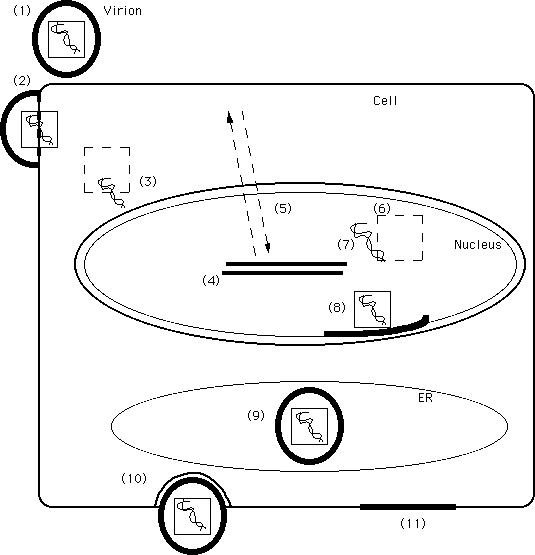herpesvirus replication: a schematic diagram

The most extensive research on herpesviral replication has been done
on HSV. It is believed that other herpesviruses follow similar
pathways, with some at slower paces than others.
(1) HSV virion attaches to host cell with the envelope glycoprotein
(gC) onto heparan sulfate moieties of cellular proteoglycans. Viral
gD is believed to bind to a secondary cellular receptor.
(2) The viral envelope fuses to the plasma membrane in a
pH-independent fashion such that the nucleocapsid enters the
cytoplasm. gB, gD, and gH are instrumental glycoproteins for this
phenomenon.
(3) The capsid travels along the cytoskeleton to a nuclear pore where
the viral DNA is released. The linear genome enters the nucleus and
circularizes.
(4) Once in the nucleus, the viral DNA is transcribed into mRNA by
cellular RNA polymerase II. In herpesviruses, viral gene expression
is tightly regulated and divided into 3 kinetic classes of expression.
* A tegument protein associates with 2 celluar proteins,
and the complex transactivates transcription of HSV's five
immediate-early (IE or alpha) genes. IE genes generally encode
regulatory proteins.
* An IE protein initiates transcription of the early (E or
beta) genes. These gene products are enzymes needed to increase the
pool of nucleotides and for viral replication.
* Lastly, late (L or gamma) genes are activated for
production of viral structural proteins.
(5) After transcription in the nucleus, all mRNA transcripts are
translated into protein in the cytoplasm. Subsequently, the proteins
can go to the nucleus, stay in the cytoplasm, or become a part of the
membrane bilayer.
(6) Capsid proteins assemble in the nucleus to form empty capsids.
(7) Full-length viral DNA is packaged to form nucleocapsids.
(8) The nucleocapsids associate with segments of the nuclear membrane
where tegument and glycosylated envelope proteins have bound. This
association triggers envelopement by budding through the nuclear
membrane.
(9) Enveloped virions accumulate in the endoplasmic reticulum (ER).
(10) Mature virions are released by exocytosis.
(11) Virus-specific proteins are also found on the plasma membrane of
infected cells.
Comments?
Created: March 2, 1999
Last modified: March 2, 1999

